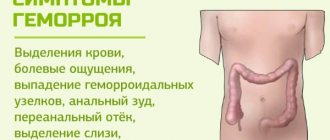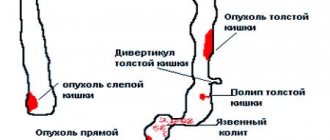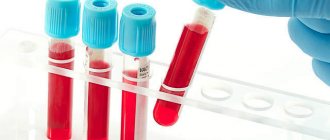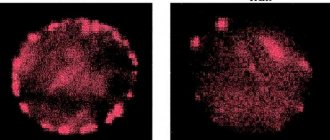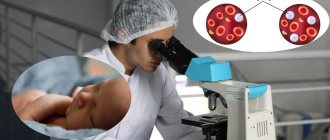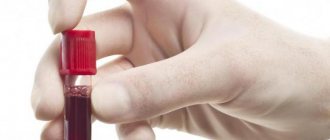A baby's stool can tell a lot about his health. It is by the contents of the diaper that a mother determines whether her baby is healthy. Having discovered mucus or foam in the stool, the mother begins to panic. But it is much more dangerous to see streaks of blood in a baby’s stool. Bloody inclusions can be a sign of serious pathologies, for which you should seek medical help as soon as possible.
But sometimes streaks in stool are not dangerous and do not require any treatment. It will be difficult to determine the cause on your own. Therefore, if there is blood in the baby’s diaper, you should consult a pediatrician.
What does normal stool look like in a child?
In the first day or two after birth, the newborn begins to pass the original feces - meconium. It is black in color with a greenish tint, viscous consistency and has no characteristic odor. The appearance of meconium is proof that the baby's intestines are working normally. On the third or fourth day, the baby’s stool takes on a different color and consistency. Usually at this time the mother and baby are discharged from the maternity hospital home. So, by this moment the meconium should completely leave the child’s body.
By the second week of a newborn's life, his stool turns yellow or mustard. It has a liquid, mushy consistency. The smell of the stool is faint and sour. The presence of white grains or a small amount of mucus in the stool is acceptable. The main thing is that the stool is not too dense or, conversely, watery.
At each diaper change, its contents should be inspected in order to identify pathology in time. It should be remembered that the nature of the stool is an important indicator of the baby’s health.
Carbohydrates in feces
Milk sugar or lactose is a carbohydrate that in a healthy body must be broken down and digested using lactase. Otherwise, it is not absorbed and contributes to the proliferation of bacteria and disorder of the intestinal microflora.
To exclude or confirm the disease, an analysis is prescribed for carbohydrates contained in the intestines:
- norm - up to 0.3%;
- permissible deviation - up to 0.5%;
- critical indicator - more than 1%.
The diagnosis of lactase deficiency is common in newborns.
The inability of a child to consume mother's milk and receive nutrients leads to serious consequences:
- developmental delay;
- allergic rashes and dermatitis;
- frequent loose stools. Observed more than 10 times a day;
- constipation;
- flatulence;
- anemia.
Exceeding the norm of undissolved carbohydrates indicates a lack of lactase in the body. Urgent treatment and additional study of this pathology are required.
When should you not worry?
When breastfeeding, there are several options for normal stool color and consistency. Even the absence of bowel movements for 24 hours is not considered constipation if the stool looks like a yellow, soft porridge. In fact, the color of stool may change for the following reasons:
- Products in the diet of a nursing woman. If the mother’s menu the day before included tomatoes, beets, and black currants, the baby’s stool may turn reddish. But this does not mean at all that the baby has bloody stool.
- Taking medications. If the mother takes antibiotics, medications containing iron, or tablets containing dyes, the color of the baby's stool will certainly change.
- Introduction of complementary foods. When a child is introduced to a new food, changes occur in his digestive system, including stool. This should not cause concern to the mother.
Sources of the pathological process
An infant is not yet able to tell his parents about exactly what unpleasant sensations he is experiencing, which greatly complicates the task of identifying the provocateur of the pathology. The baby is only able to convey information that something is bothering the baby through screams and restless behavior. Therefore, in most cases, determining the cause of various pathological processes is possible only with the help of laboratory tests.
Before you panic and wonder why the child pooped with blood, you need to carefully look at the stool and make sure there is blood in it. The fact is that a child's bowel movements may be dark in color, such as bleeding in the upper gastrointestinal tract, for a harmless reason: food. Some foods can stain stool, so first of all you need to remember what food your child ate. For example, eating iron-rich fruits leads to coloration of stool. Dark streaks or dots may appear in the feces. As a rule, one such “string” or point is the result of incompletely or completely undigested solid parts of food or medicine.
Why do babies have blood streaks in their stool?
It is worth noting that this problem can occur in both breastfed and bottle-fed babies. The appearance of blood in the stool can be caused by a number of factors. One of the most common causes of this condition is cracked nipples in the mother. In this case, namely during breastfeeding, blood in the baby’s stool is more normal than pathological. It enters the baby's body along with mother's milk. And since the walls of his stomach still secrete an insufficient amount of enzymes and hydrochloric acid necessary for digesting food, red streaks appear in the baby’s stool.
In general, blood in a baby's stool can come from two sources:
- From the upper parts of the digestive system. In this case, blood in the stool is explained by pathological processes in the stomach, esophagus, and duodenum.
- From the lower intestines. The reason for this condition lies in diseases of the colon and rectum, as well as the anus.
Diagnostics
If a mother sees blood in her baby’s stool once, and the child is calm and cheerful, then most likely there is no reason to panic. When the situation repeats, you cannot ignore this sign; you should consult a doctor.
To clarify the cause, examinations are prescribed:
- Test for occult blood in stool. The study makes it possible to detect changes in hemoglobin in red blood cells even when the red blood cells themselves are not detected.
- Coprogram. Stool examination, which provides general information about the functioning of different parts of the digestive system.
- Ultrasound of the abdominal cavity. Diagnostics identifies pathologies that may be asymptomatic.
- Blood analysis. Shows the general condition of the baby’s body, excludes inflammatory, infectious, and allergic diseases.
If there are indications, the doctor will prescribe an intestinal biopsy, colonoscopy, FGDS and other endoscopic examinations.
Pathological causes of blood in the stool of an infant
It is quite difficult to determine on your own why a child has scarlet streaks in his stool. For this purpose, a comprehensive examination is carried out in a medical institution. But parents should know the reasons why feces with blood streaks most often appear in infants:
- Anal fissures. This pathology is typical for children of any age, and not just for infants. In this case, the blood is located directly on the surface of the stool and remains on the toilet paper or napkin. The child experiences discomfort during bowel movements, grunts, writhes in pain, and sometimes cries a lot.
- Allergic reaction. This problem is most often encountered by children on artificial or mixed feeding. Blood in the stool occurs due to an allergy to the milk protein that is part of the mixture.
- Intussusception. The pathology most often occurs in children from 4 months to 1 year. The disease begins acutely, with severe abdominal pain and vomiting. In this case, the feces resemble the consistency of jelly with admixtures of mucus and blood.
- Intestinal infections. Infants are extremely rarely affected by diseases such as dysentery, typhoid fever, botulism, salmonellosis. But parents should be wary of such dangerous symptoms as diarrhea streaked with blood, nausea, and fever.
- Polyps. The disease is accompanied by constant constipation, difficulties with defecation and streaks of blood in the stool. This pathology can only be treated surgically.
- Helminthiases. It is quite difficult for an infant to become infected with worms, but for children under 5 years of age this problem is very relevant. In this case, the baby is bothered by itching in the anus, diarrhea, and interrupted sleep.
Decoding coprograms in children
Many parents are interested in what stool should actually be like in a healthy child, and whether the coprogram and its full decoding in children can be erroneous.
In some cases, a slight deviation from the norm is acceptable, especially when the baby switches to an adult or mixed diet. Let's take a closer look at what deciphering a coprogram looks like in an infant and child after the first year of life.
A lot or little feces. The amount of discharge is very ambiguous. The nutrition that a newborn baby receives consists of formula and breast milk. Therefore, bowel movements per day should not exceed 50 grams per day.
After the first year, the baby receives full-fledged adult food. The daily norm for older children reaches 250 grams.
Possible reasons for increased bowel movements:
- pancreatitis;
- cholecystitis;
- disruption of the biliary system.
The color depends entirely on what the child eats. After 6 months, a baby may pass formed brown feces. Baby and newborn - yellowish, golden.
What does a different color of stool mean:
- dark brown. Indicates obstructive jaundice, a large amount of meat in the diet;
- black. Bleeding of the stomach or intestines, duodenal ulcers. Eating dark berries;
- green. Characteristic for fans of salads and green vegetables;
- red. Bleeding of the intestines;
- clayey. Loss of coloration of bowel movements can be caused by hepatitis, neoplasms, liver diseases;
- light. It is observed in connection with the appearance of ulcerative colitis, pancreatitis, Crohn's disease, and the fermentation process.
Smell. Corresponds to the products that the child consumes. In a newborn, the smell of bowel movements corresponds to the fermentation of milk and has a sourish tint.
Mixed nutrition in a child provokes a putrid odor. The child’s body still does not cope well with digesting heavy food. After a year, stool takes on the traditional fecal smell, but not too strong.
Stool pH. Bacteria that form the intestinal microflora affect acidity levels:
- the baby's coprogram will show a result of no more than 5.8;
- a baby on artificial feeding has an indicator of up to 6.8;
- The neutral pH level of an adult child reaches 7.5.
As an exception, mucus in feces is allowed in infants up to 6 months during breastfeeding. In other cases, intestinal infections, hemorrhoids, polyps, and lactase deficiency are possible.
Stercobilin should be detected in adult children, and bilirubin is observed only in newborns. It is this that colors the stool light yellow.
should not be reflected in feces Too many of them indicate dysfunction of the digestive system. Food that is not digestible by the baby is rarely found in the discharge.
Starch should not be found in feces. It is the result of eating cereals, vegetables and fruits, and is broken down even before it enters the intestines. In other cases, it is necessary to check the child for pancreatitis and gastritis.
Fatty acids are observed only in young children. After a year, they are digested, and the remains are eliminated from the body naturally. Indicate disorders of the biliary tract, diarrhea.
Soap. They are the result of the digestion of fats. Their absence indicates possible diseases of the liver, gall bladder, and pancreatitis.
Leukocytes. Isolated cases are acceptable. A leukocyte count of more than 10 indicates an infectious disease or inflammatory process in the gastrointestinal tract, such as amoebic dysentery, colitis, enteritis, pancreatitis, or allergies.
The appearance of blood in a child’s stool in most cases causes panic among parents, but, as a rule, in childhood such an abnormal process rarely threatens the baby with a fatal disease. There are quite a large number of different provocateurs, both quite harmless and very dangerous. Therefore, in order not to guess and not miss the chance for a speedy recovery, it is recommended to contact your pediatrician when asking why your child is pooping with blood.
In addition to blood, other impurities such as mucus or foam can be seen in the stool. Additionally, other symptoms may be observed that indicate problems with the baby’s health. When visiting a pediatrician, parents should inform the doctor about all manifestations known to them.
Symptoms of pathology
Blood streaks in a baby's stool are the main sign of pathological changes in the baby's body. They do not always indicate a dangerous disease, but you should not let the situation take its course. Depending on the specific disease that caused blood clots in the stool, your child may experience the following symptoms:
- diarrhea and mucus;
- constipation, difficulty with bowel movements;
- nausea, vomiting;
- a sharp increase in body temperature;
- pain in the abdominal area (the baby cries, bending his legs).
If a child, along with bloody streaks in the stool, has at least one of the above signs, he needs additional examination to make a correct diagnosis and prescribe timely treatment.
Stool analysis in a small child under one year old
A newborn baby who is bottle-fed, as well as a child older than 6 months and up to one year old, will have completely different indicators when undergoing diagnostics.
Since an infant does not yet have a strong immune system, his tests may differ from the norm. A coprogram in a baby from six months old and an infant on a mixed diet in this case shows:
- Bowel movements per day – 30–40 grams.
- Yellow-brown tint.
- putrid smell.
- pH level – 6.8–7.5.
- There is no mucus.
- No blood is detected.
- Soluble protein is not detected.
- Stercobilin is present.
- There is bilirubin.
- There is no ammonia.
- Detritus maybe.
- Little or no muscle fibers are detected.
- There are no connecting fibers.
- There is no starch.
- Digestible fiber of plant origin is not detected.
- Neutral fat – little.
- Fatty acids – low.
- Soap - a little.
- Leukocytes are single.
A general analysis of stool in young children under one year of age is presented as a table with data. It is provided to a pediatrician for study. Do not worry if the coprogram and its norm do not coincide with the above data. An infant's immune system is still weak.
To make sure everything is fine with your baby, you can do an extensive stool test or consult a doctor.
When should you see a doctor?
Blood streaks in the stool do not always require treatment. For example, if their appearance is associated with damage to the nipples of a nursing mother or cracks in the anal area. Such simple problems often go away on their own. The main thing is to try not to aggravate the situation and help the child get rid of constipation as quickly as possible.
If there is a lot of blood in the stool, it is dark, coagulated, or, conversely, liquid and scarlet, you should immediately seek medical help. In the first case, the cause may be internal bleeding, and in the second, it may indicate problems in the lower intestines, for example, the presence of a bleeding tumor.
Causes
Anal fissures
An anal fissure is a wound in the wall of the anus, which is formed when massive or hard stool passes through the anus. Anal fissures develop in children of any age: from newborns to schoolchildren and adults. Signs of a fissure in the anus include pain, the baby straining during bowel movements, and the presence of bright red blood clots on the outside of the stool or on the diaper.
In some infants and children, a fissure in the anus is accompanied by constipation and rather hard stool. Blood in the stool of an infant occurs when constipation occurs due to overstrain of the anal sphincter muscle to release hard stool. Harder stool is also abrasive in nature, further exacerbating the problem.
Infections
Many gastrointestinal infections cause mucus and blood in a child's stool. If blood appears in the stool during diarrhea, then there is a high probability of an intestinal infection of bacterial origin (shigellosis, salmonellosis or campylobacteriosis). These bacteria cause inflammation in the intestines, causing tiny tears that leak blood into the stool.
Streptococcus bacteria can infect the skin around the anus, causing inflammation. This leads to a crack and, ultimately, blood in the child’s stool.
Sometimes, due to an infection that causes diarrhea, your baby's stool appears green and streaked with blood. The green color of stool is due to improper breakdown of bile juice. Green stool with diarrhea often occurs in infants.
Colitis
Colitis is an inflammation of the inner lining of the colon. This condition is caused by small ulcers in the colon that are painful and also cause rectal bleeding. The causes of childhood ulcerative colitis are unknown, but genetics play an important role.
Necrotizing enterocolitis causes blood in the stool of a newborn baby born prematurely. Premature babies have an underdeveloped immune system, making their organs vulnerable to infection. In this condition, bacteria invade the intestinal wall and the infection leads to inflammation, which ultimately causes blood in the stool of a premature baby.
Crohn's disease
Crohn's disease is an inflammatory disease of the large intestine, almost identical to colitis, differing only in physiology. As with colitis, there is no clear explanation for this condition. But it is believed that, first of all, the disease is caused by genetic mutations. If someone in the family, including a direct relative, has been diagnosed with Crohn's disease, the likelihood of your baby developing the disease increases.
Allergies
Food allergies can cause mucus and blood to appear in a child's stool. Your baby may develop allergies to cow's milk and infant formula, wheat, barley, rye and oats. This is a serious problem for infants who are starting solids and for those taking supplements that contain gluten as an ingredient.
For example, vitamin supplements often contain malted barley, which contains gluten.
Polyps
These are growths of tissue protruding above the surface of the colon mucosa. They can develop in children from two to ten years of age. Symptoms usually include painless rectal bleeding.
Meckel's diverticulum
This is a congenital pouch-like protrusion in the lower part of the small intestine. The mass contains cells usually found in the stomach. They produce acid and cause ulcers and bleeding in the small intestine near the diverticulum.
Intestinal obstruction
These include:
- intussusception (a form of intestinal obstruction in which part of the intestine “telescopes” into an adjacent part of the intestine);
- Hirschsprung's disease (a form of colon obstruction that develops before birth and is caused by a lack of nerve cells in the large intestine).
Both of these conditions are acute, meaning that very little time passes between their onset and the development of obvious symptoms.
Other states
Causes bloody discharge from the anus, includes bleeding disorders and abnormalities of the blood vessels inside the intestines.
These conditions are accompanied by changes in the skin (mild bruising, certain rashes) or other symptoms.
What does a stool coprogram show?
Laboratory analysis of stool will accurately determine the cause of most internal bleeding. A coprogram is prescribed in order to identify hidden blood and make a correct diagnosis of blood streaks in the stool of an infant. When interpreting the results, the following pathological changes can be identified:
- the presence of impurities in the stool, including blood, is often a sign of internal bleeding in one of the intestinal sections;
- the presence of bilirubin - this bile pigment can only be in the stool of a breastfed child, and the test must be negative on artificial or mixed;
- the presence of red blood cells or white blood cells - an excess of their norm is observed with a polyp, ulcer, helminthiasis and various formations (tumors) in the intestines;
- the presence of protein indicates an inflammatory process in the intestines;
- change in the consistency of stool - foamy stool may indicate the presence of an intestinal infection in the body.
If the infectious nature of the disease is suspected, the child is tested for microorganisms.
Treatment
If, while breastfeeding, the baby develops blood streaks in the stool, therapy depends on the cause that provoked the syndrome. To make it easier for the doctor to make a correct diagnosis, it is better to save some of the newborn’s stool and show it or take a photograph where bloody spots are visible in the stool. Before prescribing any treatment, you will have to undergo the necessary examinations, which are described below.
Diagnostics and tests
To exclude less dangerous diseases during breastfeeding, such as dysbiosis, helminthiasis and ingestion of blood due to cracks in the mother’s nipples, an analysis is performed for dysbiosis, worm eggs and the Apta-Downer test. The latter technique allows you to distinguish blood in the stool that belongs to the baby from the mother’s ichor. To do this, the required part is isolated from the baby’s feces and mixed with a sodium hydroxide solution in a centrifuge. If the mixture turns brown, the blood belongs to the mother, her hemoglobin is present; the preservation of the pink color indicates the presence of the child’s hemoglobin. Blood and urine are also taken for general analysis.
Research methods are as follows:
- Coprogram. To make a diagnosis, the presence in the stool, in addition to blood, of mucous inclusions, undigested breast milk, and remnants of red blood cells is determined. The method is fundamental in the diagnosis of intestinal diseases.
- Coagulogram. It is carried out to confirm or refute bleeding disorders. Prothrombin and thrombin time, fibrinogen are determined.
- Gregersen reaction. Before donating blood, the baby is not fed meat if he is mixed-fed. Allows you to determine hidden blood that is not observed in the stool.
- Tests for lactase deficiency. It is determined how many carbohydrates are contained in the child’s feces, hydrogen in the air exhaled by the baby after lactose has entered the body (breath test), and the process of absorption of D-xylose is assessed.
Additional hardware and laboratory testing techniques depend on the preliminary diagnosis. So, if intestinal obstruction is suspected, an x-ray with a contrast agent is performed.
Treatment methods
The principles of treatment for bloody streaks in the stool depend on the cause that caused the appearance of the alarming sign:
- frequent constipation, leading to cracks in the intestinal and anal mucosa, can be eliminated by adjusting the mother’s diet if the newborn is breastfed and by revising complementary foods with mixed feeding;
- intestinal obstruction is treated surgically, the doctor performs manual straightening of the intussusception;
- therapy for intestinal infections is based on rehydration and antibiotics;
- an allergy to cow's milk is eliminated by replacing it with a highly adaptive hypoallergenic formula, and when breastfeeding, by correcting the mother's diet;
- lactase deficiency is treated by administering lactose-free baby food to the baby - Nutrilon, Humana, Enfamil;
- treatment of hemorrhagic disease is carried out by introducing into the body a synthetic analogue of vitamin K - the drug Vikasol;
- rectal polyps, including juvenile ones, are assessed in terms of size and danger to the baby’s health - the decision on the need for removal is made by the doctor;
- helminthic infestations are treated by taking antiparasitic drugs in children's dosages, maintaining hygiene and limiting contact with the source of infection (it is necessary to deworm pets, boil bed linen, and disinfect the premises).
These are the treatment methods necessary for the appearance of bloody streaks in the stool of infants. Additional medications and methods will be prescribed by the attending physician, depending on the provoking factor.
If it is not possible to immediately determine the cause of the appearance of blood in the baby’s stool, it is better not to refuse hospitalization. In a hospital setting, mothers will be helped to establish the feeding process, monitor the child’s condition, and carry out a wide range of diagnostic procedures. This applies to situations where blood in the stool is accompanied by insufficient weight gain in the infant, poor sleep and appetite, and signs of abdominal pain. Even in the absence of danger symptoms, bloody spots in the baby’s stool should not go unnoticed by parents and pediatricians.
Therapeutic measures
If blood streaks are detected in a baby's stool, self-therapy can be even more dangerous than the disease itself. It must be remembered that treatment is prescribed only after receiving the results of the examination and making the correct diagnosis.
Depending on the reason for the appearance of blood in the baby’s stool, the following types of therapy may be indicated:
- a diet that excludes allergenic foods;
- ointments, creams;
- antiviral and antimicrobial drugs, antibiotics;
- for constipation - a laxative (for example, Duphalac).
In particularly difficult cases, only surgical intervention can solve the problem.
Methods of diagnosis and determination of causes
To determine the cause of the appearance of blood in a child’s stool, it is often enough for a doctor to collect information and visually examine the baby. It is mandatory to perform palpation (rectal examination) in the anus and submit stool samples for laboratory tests. If the causes of bleeding are unclear, additional, more in-depth diagnostic methods are prescribed - X-ray or ultrasound, endoscopic examinations.
Analyzes
If there is a suspicion of internal bleeding or occult blood, a coprogram (Gregersen test) is prescribed. Prepare for the analysis in advance, exclude from the child’s menu dishes with meat and fish, herbs, vegetables (cucumbers, tomatoes, cabbage) and medications containing iron. Stool collection for examination occurs after the natural act of defecation. A transcript of the analysis is printed on special forms - a negative or positive reaction to occult blood. A small patient is prescribed a clinical test of blood and urine, as well as stool to determine helminth eggs.
Sigmoidoscopy
To make an accurate diagnosis, sigmoidoscopy, a type of endoscopic examination, is prescribed. The most accessible and common type of examination of the large intestine is using a rectoscope - a device consisting of a long tube with a video camera and a device that pumps air. The method is used in hospital and outpatient settings, is completely safe, and helps to visually determine the condition of the colon mucosa. To get a clear and clear picture, preparatory procedures are necessary. The doctor prescribes a special diet for the child (for a couple of days); before the examination, you cannot eat for several hours. The procedure is carried out exclusively on an empty stomach. If no pathology is detected using sigmoidoscopy, another study is prescribed.
Colonoscopy
Another common type of diagnostic test using an endoscope is called a colonoscopy. This procedure is aimed at identifying various intestinal pathologies; the development of inflammatory processes, malignant tumors, and polyps can be detected in time. For a child, the study is carried out not only for the purpose of diagnosis, but also for treatment. Using the colonoscopy method, it is possible to perform local mini-surgeries to remove polyps and foreign bodies from the large and rectal intestines. During the procedure, a small amount of mucous membrane is removed for histological analysis. Before the examination, the same doctor’s recommendations are followed as for sigmoidoscopy.
Advice from experienced pediatricians and Dr. Komarovsky’s opinion on the problem
A well-known pediatrician believes that parents should not ignore the presence of blood streaks in their baby’s stool. Komarovsky believes that constipation is often the cause of this condition. He recommends that a nursing mother change her diet to include prunes, fermented milk products, and clean water. You should definitely use elements of therapeutic exercises with flexion and extension of the legs.
Pediatricians warn parents that blood in the stool is not normal for healthy children. Their advice boils down to the following:
- The presence of blood streaks in the stool, along with an increase in temperature, frequent loose stools mixed with mucus, vomiting, and abdominal pain, requires immediate contact with a pediatrician or infectious disease doctor.
- Late visit to the doctor if there is blood in the stool for a long time only aggravates the current situation and complicates treatment.
- Experts (gastroenterologists and proctological surgeons) do not advise self-medication and immediately consult a doctor if blood is detected in the stool of an infant. Komarovsky believes that a pediatrician should be visited even if no other symptoms of dangerous diseases are detected.
Examination of feces for occult blood
If a child or a doctor suspects the presence of internal bleeding, small lesions and possible damage to the integrity of the tissue of the digestive organs, it is necessary to urgently undergo an appropriate examination.
A special laboratory analysis of stool for “hidden” blood in children is carried out:
- immunochemical. A method using antibodies that detect not only blood cells, but can also determine the cause of their occurrence;
- Gregersen reaction. Involves applying a small amount of reagent to the fecal composition. A change in the color of bowel movements indicates the presence of “hidden” blood.
Very often, a careful interpretation of a stool test turns out to be false positive or false negative. In this case, the examination must be repeated.
If the stool test for occult blood is positive, then a diagnosis of possible diseases is required:
- ulcerative lesions of the stomach, duodenum;
- Mallory-Weiss syndrome;
- varicose veins in the esophagus;
- liver dysfunction;
- periodontal disease;
- stomatitis;
- neoplasms, tumors;
- nosebleeds;
- intestinal obstruction;
- food allergies;
- polyps in the intestines;
- helminthiasis;
- dysentery;
- colitis;
- dysbiosis.
The usual macro and microscopic study of defecation in this case is not informative. Hemoglobin, which breaks down, is synthesized into ferrous sulfate. The stool takes on a dark color without traces of blood.
Only the immunochemical laboratory method can show reliable results. Its only drawback is the duration of the event. The study takes about 2 weeks.
Preventive measures
The younger the baby is, the more difficult it is for him to endure even the mildest illness. Therefore, in order not to engage in long-term treatment, it is necessary to carry out preventive measures in a timely manner:
- Starting from infancy, teach your child to wash their hands with soap, which will avoid intestinal infections and helminth infection.
- Provide balanced nutrition to mother and child to avoid the formation of hard feces.
- If salmonellosis is detected in one of the adult family members, he should be isolated from contact with children to avoid infection.
Possible symptoms
Parents of the child should be concerned about the following symptoms:
A child's refusal to eat is considered an alarming symptom.
- disturbance of general well-being;
- severe crying during bowel movements;
- the presence in the stool of not only bloody impurities, but also pus and mucus;
- persistently elevated body temperature without signs of acute respiratory infections;
- refusal to eat and weight loss;
- nausea, vomiting, pain in the lower abdomen;
- weakness, drowsiness;
- cyanosis of the skin;
- itching and burning near the anus;
- pain when pressing on the anus;
- if external hemorrhoids develop, attentive parents will notice the presence of inflamed hemorrhoids.
Because of the cracks, the child feels pain when defecating; the stool may be hard; it is this consistency that leads to microtrauma of the anus. With rectal cancer, the baby complains of abdominal pain, loses significant weight and looks unhealthy. The main thing that is important for parents to do in this case is to immediately take the baby to the pediatrician, because the sooner the pathology is identified, the easier it is to get rid of it.
Return to contents
Other symptoms requiring close parental attention
Sometimes streaks of blood in a child's stool occur due to the fault of the parents, even if they want to help him. Injury to the anus, which will lead to the appearance of blood in the baby’s stool, can be caused by parental negligence. Very often, when a child experiences constipation, parents resort to using a small piece of soap or a pear to help him. When a foreign object is inserted into a child's anus, accidental injury to the mucous membrane may occur.
Another common reason that can lead to the appearance of blood streaks in a child’s stool is increased gas formation in the intestines, which damages its blood vessels.
Streaks in a baby's stool can cause quite serious diseases, such as intestinal obstruction and Hirschsprung's disease (significant dilation of the colon). As a rule, these abnormal processes are congenital.
Another 2 dangerous pathological causes that cause blood clots in the stool of a child under one year of age are volvulus and intussusception.
If the baby is calm, behaves cheerfully during the day, sleeps well, does not lose appetite, etc., but mucus (sometimes with a green tint) appears in his stool, then in most cases this is a sign that the child is at the transition stage. An alarming symptom is the appearance of green mucus streaked with blood and an unpleasant odor. Such changes are characteristic of intestinal infections. Mucus with blood in the stool of a baby can occur due to the development of an inflammatory process in the mucous membranes of the digestive tract or due to poisoning of the body.
The presence of mucus in children's feces in a small amount without any other impurities is not a sign of a pathological process, but if blood is found there, then you should definitely seek medical help.
Streaks of blood in a baby's stool can result from the use of certain medications (most often antibiotics). As a rule, the doctor talks about the possible reactions of the body during treatment with one or another drug. But the human factor must also be taken into account. The doctor may not have reported the likelihood of such consequences, or after taking the prescribed drug, blood should not have appeared in the child’s stool. If the pediatrician did not say anything, but the parents noticed that during the treatment the child is pooping with blood, they should definitely consult a doctor to find out the reason for this reaction of the body.
What to do
If a child has blood in the stool, parents should immediately seek qualified medical help. You should not try to treat children on your own or only with alternative medicine recipes.
Medicines and methods
The choice of drug depends on the cause of bleeding. For Crohn's disease, the patient is prescribed symptomatic treatment, the purpose of which is to eliminate discomfort. For intestinal infections, the child needs antibiotics, which should be selected by the doctor taking into account the patient’s age and the bacteria that caused the diarrhea. Uncontrolled use of antibiotics leads to dysbiosis, which can be avoided by using prebiotics and probiotics prescribed by the pediatrician. Children may be prescribed medications for constipation.
If feces streaked with blood in a baby are the result of polyps or tumors, the patient needs surgical intervention.
Folk remedies
When the cause of the appearance of blood streaks in a child’s stool has been established, you can use folk recipes:
- Nettle decoction. The drug helps stop bleeding. A decoction is prepared from 1 tsp. plants and a glass of boiling water. If the child refuses the drink, the nettle can be replaced with orange peels.
- Enema with chamomile infusion. The enema is used only 2-3 days after the bleeding has stopped. It is necessary for the child to poop before the procedure. The decoction is prepared from 1 tbsp. l. chamomile flowers and 0.4 liters of boiling water. The solution should cool to a temperature of +36…+38ºС. Chamomile has a healing and hemostatic effect. The procedure can be repeated no more than 3-4 times with a break of 1-2 days.
- Celandine decoction. The medicine helps with polyps. A decoction is prepared from 1 tsp. plants and 0.5 liters of boiling water. Celandine is considered poisonous. It is advisable to use the medicine under the supervision of a doctor. The decoction is suitable for both enemas and oral administration.
- Onion infusion. The medicine is recommended for children suffering from helminthic infestations, which also cause bleeding. Finely chop the onion and pour hot milk. After 30-40 minutes, the infusion can be taken. The medicine is contraindicated in patients suffering from stomach diseases.
Important information: How many days does blood last after a caesarean section?
All medications are taken half an hour before meals in the morning or in the middle of the day. An enema that has a laxative effect can be done in the evening. The course of treatment with traditional recipes should not last more than 10 days. Dried plants are used to prepare decoctions and solutions. The course can be carried out during or after drug treatment.
Diagnostic measures
If your baby has mild bleeding, laboratory tests will help identify the presence of blood in the stool. To take the test, a child must stop brushing his teeth for three days; he is also prohibited from eating fish and meat, or taking medications that contain iron.
Parents must collect feces and submit them to the laboratory. Next, specialists will conduct testing by applying a smear to a glass slide. It is worth noting that they first dissolve the feces in acetic acid. If the biological material turns green or blue, it means there is occult blood in the feces.
To diagnose pathologies that provoke bleeding, specialists conduct hardware examinations of young patients:
- Colonoscopy . This technique allows you to examine the condition of the large intestine.
- Palpation . It is performed to examine the baby for hemorrhoids and anal fissures.
- Sigmoidoscopy . Prescribed when there is a need to examine the lower intestinal sections.
- Ultrasound . Ultrasound examination of the gastrointestinal tract can identify progressive pathologies.
